After a less-than-perfect Galaxy S22 Ultra, it’s time for Samsung to step up their game with their new flagship, the Galaxy S23 Ultra. With a high price tag, it aims to be the hypercar of smartphones, the pinnacle of its kind, an impeccable and slightly extravagant product.
These are big shoes to fill for a smartphone. The S23 Ultra boasts an ultra-versatile camera with its X10, regained power with the Snapdragon 8 Gen 2, a flawless screen from Samsung Display, and a bold design that bids farewell to the camera block while welcoming the stylus. The promise on paper is tempting, but how does it hold up in reality? Find out in this review.
Samsung Galaxy S23 Ultra Specs
| Model | Samsung Galaxy S23 Ultra |
| Dimensions | 7.81 cm x 16.34 cm x 8.9 mm |
| Manufacturer Interface | One UI |
| Screen Size | 6.8 inches |
| Resolution | 3088 x 1440 pixels |
| Pixel Density | 500 ppi |
| Technology | AMOLED |
| SoC | Qualcomm Snapdragon 8 Gen 2 |
| GPU | Qualcomm Adreno 740 |
| Internal Storage | 256 GB, 0 GB, 1000 GB |
| Rear Camera | Sensor 1: 200 Mp, Sensor 2: 12 Mp, Sensor 3: 10 Mp, Sensor 4: 10 Mp |
| Front Camera | 12 Mp |
| Video Recording | Resolution: 8K |
| Wi-Fi | Wi-Fi 6E |
| Bluetooth | 5.3 |
| 5G | Yes |
| NFC | Yes |
| Fingerprint Sensor | Under the screen |
| Connector Type | USB Type-C |
| Battery Capacity | 5000 mAh |
| Weight | 233 g |
| Colors | Black, Purple, Green, Beige |
| Repairability Index | 8.2/10 |
| Price | $999 |
Samsung Galaxy S23 Ultra: A More Comfortable Design
At first glance, the Samsung Galaxy S23 Ultra looks identical to its predecessor. Rectangular appearance, camera block replaced by three island-like cameras, and oversized dimensions (163.4 x 78.1 x 8.9 mm) make it seem like the same device, as many comments pointed out during its unveiling.
While the S22 Ultra is not far off, one fundamental change becomes apparent rather quickly: the grip. The edges have significantly flattened, providing a more comfortable and secure grip, perfect for using the stylus, which requires a solid grip for smooth writing. The phone is also less likely to slip from your fingers. However, this design choice further emphasizes its bulkiness. If you were already intimidated by the Galaxy S22 Ultra, you might feel even more so here. Despite its heft, you’ll get used to its generous size after two or three days. The 234g weight, although noticeable, doesn’t cause any discomfort.
This phone also features a colossal 6.8-inch screen, which we will discuss in more detail later. The flat edges somewhat mitigate the curved screen, resulting in a less pronounced curvature and improved comfort.
In summary, Samsung doesn’t cut corners when it comes to design and brings together everything we expect from a high-end smartphone: IP68 rating, Gorilla Glass Victus 2 (supposed to withstand a one-meter drop onto concrete), and a matte finish that resists fingerprints well. Additionally, there’s an under-display fingerprint sensor that is highly responsive and well-placed buttons, although those with small hands may need to slightly adjust their grip to access them.

To complete the phone tour, note that the punch-hole camera is located centrally, not the ideal position for fully enjoying multimedia content, but given the screen size, it’s forgivable. There’s also a slot for the stylus on the lower left edge of the phone. If you’re right-handed, it may not be the most convenient location. The stylus slot is near a USB-C port and a dual SIM tray.
Samsung Galaxy S23 Ultra: The Flawless Screen
The Samsung Galaxy S23 Ultra features one of the largest screens on the market. It has a 6.8-inch DYNAMIC AMOLED x2 display, adaptive up to 120 Hz and down to 1 Hz, with QHD resolution. In terms of brightness, Samsung promises up to 1750 cd/m².
Undoubtedly, this display is a pleasure to use daily, mainly due to its size, which allows for seeing fine details in images that smaller screens wouldn’t reveal.
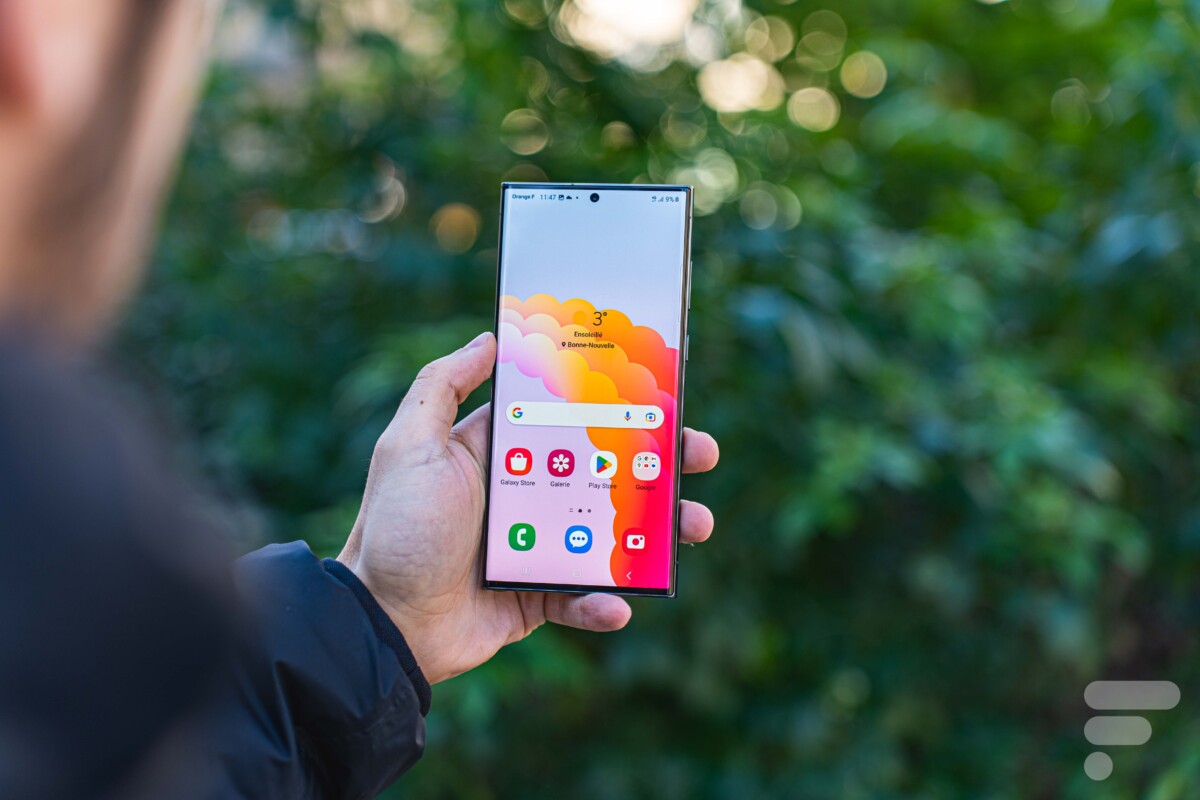
After being analyzed by our probe and Portrait Displays’ CalMAN Ultimate software, the screen of the S23 Ultra reveals its secrets. In Vivid mode, color fidelity is slightly off with an average Delta E of 4.58. For reference, a Delta E of 3 is targeted for a natural result. In exchange, the color range is impressive: 184% of sRGB is covered, 123% of DCI-P3, and even 83% of BT.2020. The screen has a slight blue tint with a temperature of 6992 K, but it’s not too far from the ideal 6500 K of white light.
While HDR allows for more vibrant colors and brightness levels, it also causes the phone to lose precision. In HDR, the average Delta E increases to 7.59.
In Natural mode, the Delta E gains accuracy, dropping to 3.93, but at the cost of the aforementioned color explosion. The color gamut drops to just 105% of sRGB and 70% of DCI-P3. However, the color temperature becomes excellent at 6467 K.
The maximum brightness we measured is 1086 cd/m² in SDR and 1609 cd/m² in peak HDR. This is an excellent score; very few phones exceed 1000 in SDR in our tests, and using the phone in direct sunlight won’t be a problem. In the evening, you won’t strain your eyes: we measured 0.77 cd/m² and even 0.11 cd/m² with the “dimmed brightness” setting.
Samsung Galaxy S23 Ultra One UI 5.1: Finally Mastering the Software
The Galaxy S23 Ultra runs on One UI 5.1, a version of Samsung’s in-house interface launched alongside the phones and based on Android 13. Samsung’s now well-established interface focuses on easy one-handed use. Even with a large device like the S23 Ultra, it’s true that the small tiles are conveniently placed for easy access.
The main new feature is the animations. Samsung has often been criticized for their slowness or somewhat laggy nature. That’s now a thing of the past. In fact, it’s the opposite: it seems Samsung has pushed the speed slider to the extreme, to the point where you no longer see animations when moving quickly through the interface. While this can be a bit disorienting at first, it’s also very pleasant when you’re in a hurry.

New delightful features include the arrival of modes like on iOS. Fully customizable, you can create, for example, a reading mode that silences all messaging app notifications while retaining access to news, reading, and music apps. Each mode can be linked to a specific wallpaper, and the status bar even displays an icon corresponding to the current mode. Additionally, you can automate modes based on time, location, or the active app.
With One UI 5, you can further personalize your lock screen. Android 13’s new features are also welcome, such as the ability to block game notifications after installing an app or choosing a language for each application.
Samsung now integrates interesting proprietary apps into its Galaxy Store, like Camera Assistant, which allows for more advanced camera controls. This is a great addition. However, the Korean company is a bit greedy with the space allocated to its system. Without any user-installed apps, the phone starts with nearly 40GB preinstalled, which seems excessive considering Windows 11 weighs 30GB and the system on a Pixel 7 Pro, supposed to be the reference, is only 15GB.
Speaking of additions, let’s not forget the S-Pen. When you take it out, a small shortcut bar appears, offering compatible apps you’ve pre-registered. A single click on one of them launches the app after a brief one to two-second loading time. You can also take out the S Pen with the phone locked and write on a black screen like an Always On display before saving the note. Convenient.
Add four years of Android updates and five years of security support, and the Galaxy S23 Ultra provides a fantastic software experience. DRM Widevine L1 ensures at least Full HD videos on streaming platforms, with no issues on that front.
Samsung Galaxy S23 Ultra Photo: Versatility sprinkled with 200MP
The photo configuration of the Galaxy S23 Ultra is as follows:
- Ultra-wide lens, 12MP sensor, autofocus, 1.4μm pixel size, 120° FOV, F/2.2;
- Wide-angle lens, 200MP, 0.6μm pixel size (equivalent to 2.4μm in 12MP), 85° FOV, F/1.7;
- 3x telephoto lens, 10MP, 1.12μm pixel size, 11° FOV, F/4.9;
- 10x telephoto lens, 10MP, 1.12μm pixel size, 36° FOV, F/2.4.
- Selfie, 12MP, dual photodiode, autofocus, 1.12μm pixel size, 80° FOV, F/2.2.
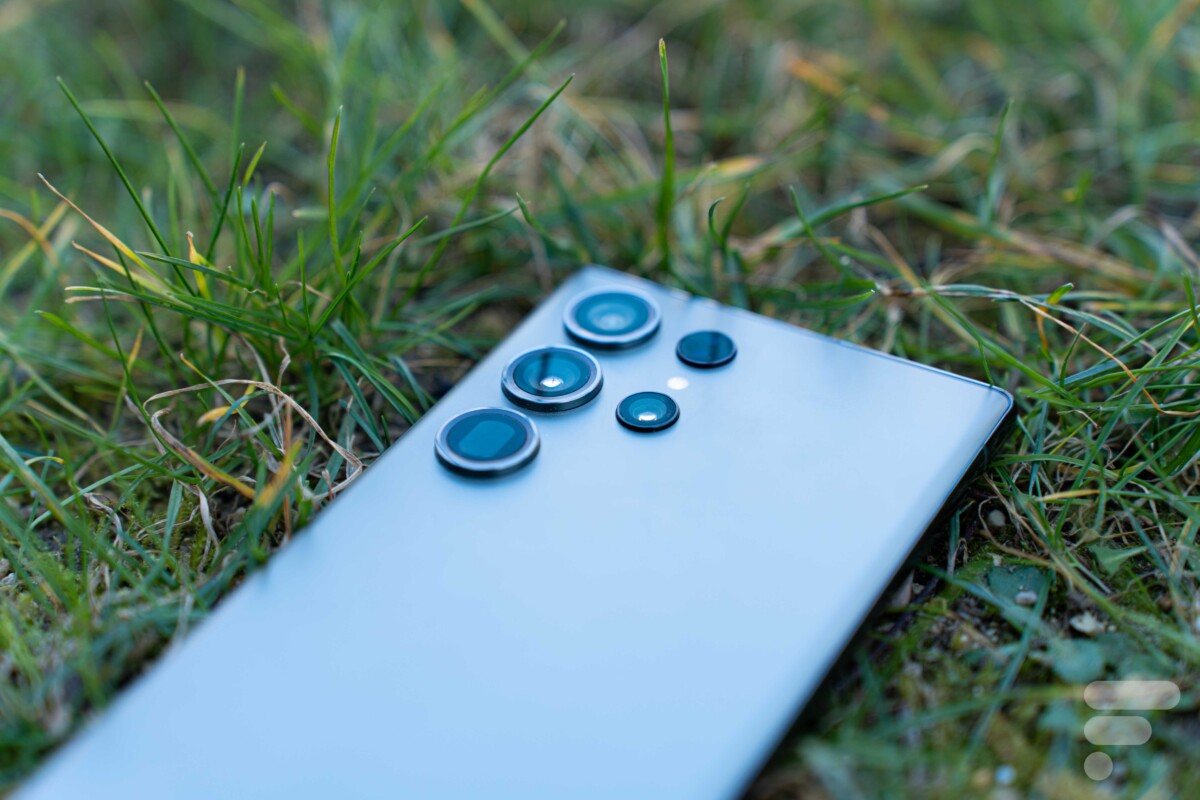
The phone can record up to 8K/30 FPS or 4K/60 FPS.
Main sensor
The Galaxy S23 Ultra’s main sensor is one of the standout features with its 200MP resolution. Of course, the base images don’t go up to such a high resolution, utilizing pixel binning to merge pixels and produce 12MP images.
Color processing is much less magenta than usual, leaning towards slightly more greenish hues. Another improvement is the increased clarity, reminiscent of Google Pixel’s processing in some aspects. This is evident in the first image with highly detailed stones and the cat’s fur texture.
The result is outstanding. The surreal aspect of the photos is reduced for more accurate colors while maintaining just enough vibrancy to make each image visually appealing.
The only minor issue is the occasional autofocus problem when the subject moves, likely due to a slightly slow shutter speed. In the cat photos above, multiple attempts were needed to achieve a sharp result.
50MP and 200MP
By navigating to the top panel of the interface, you can enable 50 and 200-megapixel modes. Here are two comparisons to give you an idea of what they offer. We have deliberately zoomed into the image to better see the details captured.
First, the 200 megapixels compared to 12 megapixels. Without any pun intended, there’s no comparison. We go from a blurry image, where it’s hard to guess the details, to something much clearer.
![]()
![]()
Naturally, the difference between 50 and 200 megapixels is less noticeable. In 50 megapixels, you already retain more details. Elements with rather coarse details, like the mural, are already well-defined. However, with 200 megapixels, you undoubtedly gain sharpness. This is particularly noticeable on the tree and foliage filled with small details.
![]()
![]()
Ultra wide-angle
Under good conditions, the wide-angle sensor’s qualities are found when using the ultra wide-angle. Here too, the colorimetry has been toned down and the micro-contrasts have been pushed. The result is quite impressive for an ultra wide-angle, which is often the weaker sensor. We can see ourselves using these shots.
The only time the ultra wide-angle struggles is when there’s a lack of light. In night photography, the result isn’t very convincing. In the picture of the cat in the cat tree, we can see that the focus struggles to lock onto its head as well.
3x telephoto
Once again, for the 3x telephoto lens, under good conditions, there’s nothing to complain about. Look at this fruit basket or the arch. The sharpness is perfect, and the shots are ready to be posted.
However, I noticed some issues under artificial light, as you can see in the photo of the two cats with the black and white chair. Here, you can feel the processing applies a slight haze to the subjects or doesn’t completely eliminate it. It’s not a big deal, as it’s a complicated situation.
10x telephoto
You know the money shot in movies? It’s a sequence that’s supposed to give you your money’s worth (or the producer’s). With the S23 Ultra’s 10x telephoto, you are really in this category. Only high-end phones like this one offer it, and even in this category of expensive phones, it remains rare.
Put it in the hands of people who have never had the chance to try a telephoto lens with such a zoom factor, and the effect is guaranteed. The sense of control and sharpness is immediate. Suddenly, to frame a detail, there’s no need to get closer; just click on 10x.
As you can see in the close-up shots of my colleagues, the result, even if it lacks a bit of sharpness, offers a truly surprising framing. The details that this 10x optical zoom can retain are quite breathtaking, like in the photo of the brown radiator or the Parisian murals.
The only limitation: if the subject isn’t perfectly still, the phone may struggle to maintain focus. An example is shown below with a cat in motion.
30x and 100x zoom
While digital zooms do not offer the same precision as optical zooms, it must be admitted that the improvements in this area are quite astounding.
The Galaxy S23 Ultra is not far behind the Pixel 7 Pro and its Super Res Zoom. In fact, it is even sharper in certain situations, like with the statue or the door in the image. If you don’t zoom in, it can be hard to tell that these photos were taken with a digital zoom. Impressive.
The 100x zoom is a bit more hit-or-miss. You can feel the algorithms doing their best to fill in missing information, but the results are still not very usable. At least we can appreciate the ability to capture a detail.
Night
At night, the Galaxy S23 Ultra leans more towards realism than turning day into night. Under street lighting, this produces photos that are slightly brighter than reality to extract maximum detail, at the cost of some lens flare. With less intense lighting, the smartphone manages to eliminate light rays quite well.

In darker scenes, the result is aesthetically pleasing and successful. Nice sharpness, not too much light, even if we can regret a little lack of clarity here and there. Especially with a moving subject like a cat.
The 3x zoom performs very well at night, particularly with indoor lighting. Photos are sharp, and the white balance is accurate. Outdoors, things get a bit more complicated, especially with sharpness, but nothing is a deal-breaker.
The 10x zoom handles indoor lighting just as well in the evening. Here too, sharpness and accurate white balance are present.

Portrait
The Galaxy S23 Ultra’s portrait mode effectively separates the subject from the background by applying a beautiful background blur. Even on the most unruly hair, it works, although some strands may be slightly shortened.
Like any portrait mode, sometimes photos can be completely ruined, as seen in these two photos that give me a divine look, but completely miss the color balance, the cutout of my cat, or even the light effects in the background.
Where portrait mode particularly shines is with the 3x zoom. This is where it truly shows off its talents. The subject is well cut out, and the sharpness is excellent. A real pleasure. Even in a slightly tricky situation with artificial lighting, like the blue photo of my colleague Anthony, you can see that the phone manages to produce an aesthetically pleasing result.
Selfie
Selfies are decent without being mind-blowing. A lot of detail is retained on the subject, and HDR is well managed, as evidenced by the blue sky behind me. However, sharpness is lost in the rest of the background scene.
Video
In terms of video, the device can go up to 4K at 60 FPS or 8K at 30 FPS. Stabilization is quite honest, with no abrupt jerks. However, around 4 seconds in, when I move the camera abruptly, there is an unattractive effect with the refresh rate appearing jerky.
Samsung Galaxy S23 Ultra Performance: Day and Night
The Galaxy S23 Ultra is equipped with Qualcomm’s Snapdragon 8 Gen 2, including for its USD version. This is the major innovation of this generation, undeniably. Last year, the Exynos 2200 powered the Galaxy S22 Ultra, and its performance level was quite disappointing.
The Galaxy S23 Ultra comes with 8 or 12 GB of RAM and 256 GB to 1 TB of UFS 4.0 storage.
| Model | Samsung Galaxy S23 Ultra | Samsung Galaxy S22 Ultra | OnePlus 11 | Asus Zenfone 9 | Apple iPhone 14 Pro |
|---|---|---|---|---|---|
| AnTuTu 9 | 1,205,251 | 934,653 | 11,039,994 | 1,085,542 | 949,082 |
| AnTuTu CPU | 261,530 | 226,613 | 201,223 | 255,974 | 238,980 |
| AnTuTu GPU | 529,047 | 404,136 | 535,813 | 468,392 | 413,733 |
| AnTuTu MEM | 240,124 | 154,007 | 212,627 | 181,036 | 153,747 |
| AnTuTu UX | 174,124 | 142,592 | 154,331 | 180,140 | 142,622 |
| PC Mark 3.0 | 15,899 | 13,216 | 10,052 | 16,292 | N/A |
| 3DMark Slingshot Extreme | N/A | N/A | N/A | N/A | 3,258 |
| 3DMark Wild Life | N/A | 7,676 | N/A | N/A | N/A |
| 3DMark Wild Life average framerate | N/A | 46 FPS | N/A | N/A | N/A |
| 3DMark Wild Life Extreme | 3,781 | 2,163 | 3,536 | 2,776 | N/A |
| 3DMark Wild Life Extreme average framerate | 23 FPS | 13 FPS | 21.20 FPS | 16.6 FPS | N/A |
| GFXBench Aztec Vulkan/Metal high (onscreen / offscreen) | 97 / 70 FPS | 29 / 32 FPS | 53 / 31 FPS | 67 / 51 FPS | N/A |
| GFXBench Car Chase (onscreen / offscreen) | 108 / 126 FPS | 32 / 60 FPS | 55 / 125 FPS | 89 / 103 FPS | N/A |
| GFXBench Manhattan 3.0 (onscreen / offscreen) | 120 / 303 FPS | 85 / 136 FPS | 60 / 318 FPS | 119 / 258 FPS | N/A |
| Geekbench 5 Single-core | 1,538 | 1,240 | 1,168 | N/A | 1,858 |
| Geekbench 5 Multi-core | 5,036 | 3,896 | 4,677 | N/A | 5,014 |
| Geekbench 5 Compute | 9,588 | 9,103 | 8,861 | N/A | 15,725 |
| Sequential read/write | 3,011 / 1,743 MB/s | 1,920 / 1,307 MB/s | 3,040 / 2,572 MB/s | 1,955 / 1,453 MB/s | N/A |
| Random read/write | 109,659 / 38,793 IOPS | 66,203 / 68,887 IOPS | 93,033 / 136,866 IOPS | 94,123 / 125,455 IOPS | N/A |
From the initial benchmarks, it’s clear that the Galaxy S23 Ultra is in a different league than its predecessor. The phone surpasses the S22 Ultra in almost all benchmarks. The GPU results are even more striking, with a gain of 10 FPS, a 77% increase, in 3D Mark Wild Life Extreme.
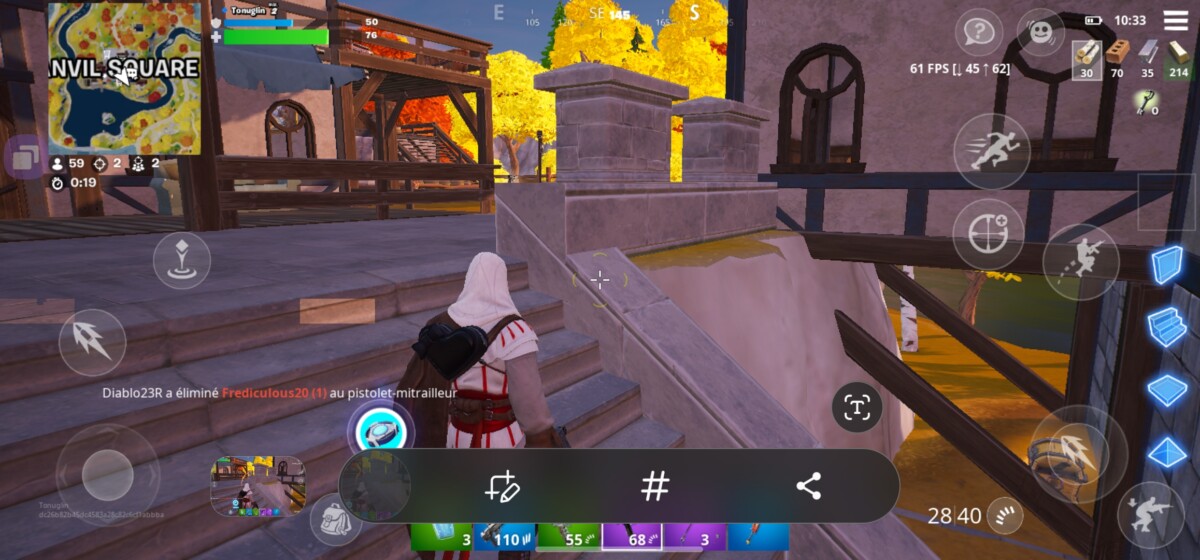
In gaming, the improvements are noticeable as well. Genshin Impact runs smoothly and stably, even with maximum settings and at 60 FPS. During a 20-30 minute session, the refresh rate remained stable. The temperature peaks at 40°C, and the heating sensation is not bothersome at all. Impressive performance.
As for Fortnite, it’s a bit more unstable at the maximum quality level at the beginning of the game, with some lags slowing it down significantly. However, once the game starts, no major issues to report. The game runs at an average of 50 FPS with “high” settings.
On a daily basis, apart from a few minor lags when starting the phone on the first day, we experienced no slowdowns. The phone reacts responsively, as expected from a premium device.
Samsung Galaxy S23 Ultra Battery: A Major Strength
The Galaxy S23 Ultra features a 5000 mAh battery. On paper, it’s a large capacity, but it’s not uncommon to find phones with disappointing battery life with such configurations. The Galaxy S23 Ultra is not one of them.
Let’s put it this way: we test a lot of phones at GoStart.Biz. When they last more than a day, it’s generally good, when they reach two days, we celebrate. So when I saw the S23 Ultra effortlessly go into its third day, I thought I was going crazy. To be more precise, I unplugged the phone on Sunday around 10 am, and by Tuesday morning, approaching 11 am, I still had 26% battery life left. Indestructible.
Admittedly, my usage wasn’t the most intense. Only 7 hours and 25 minutes of screen time, or about 3 hours and 30 minutes per day over 48 hours. Usually, my screen time is similar, and I never, ever achieve this level of performance.
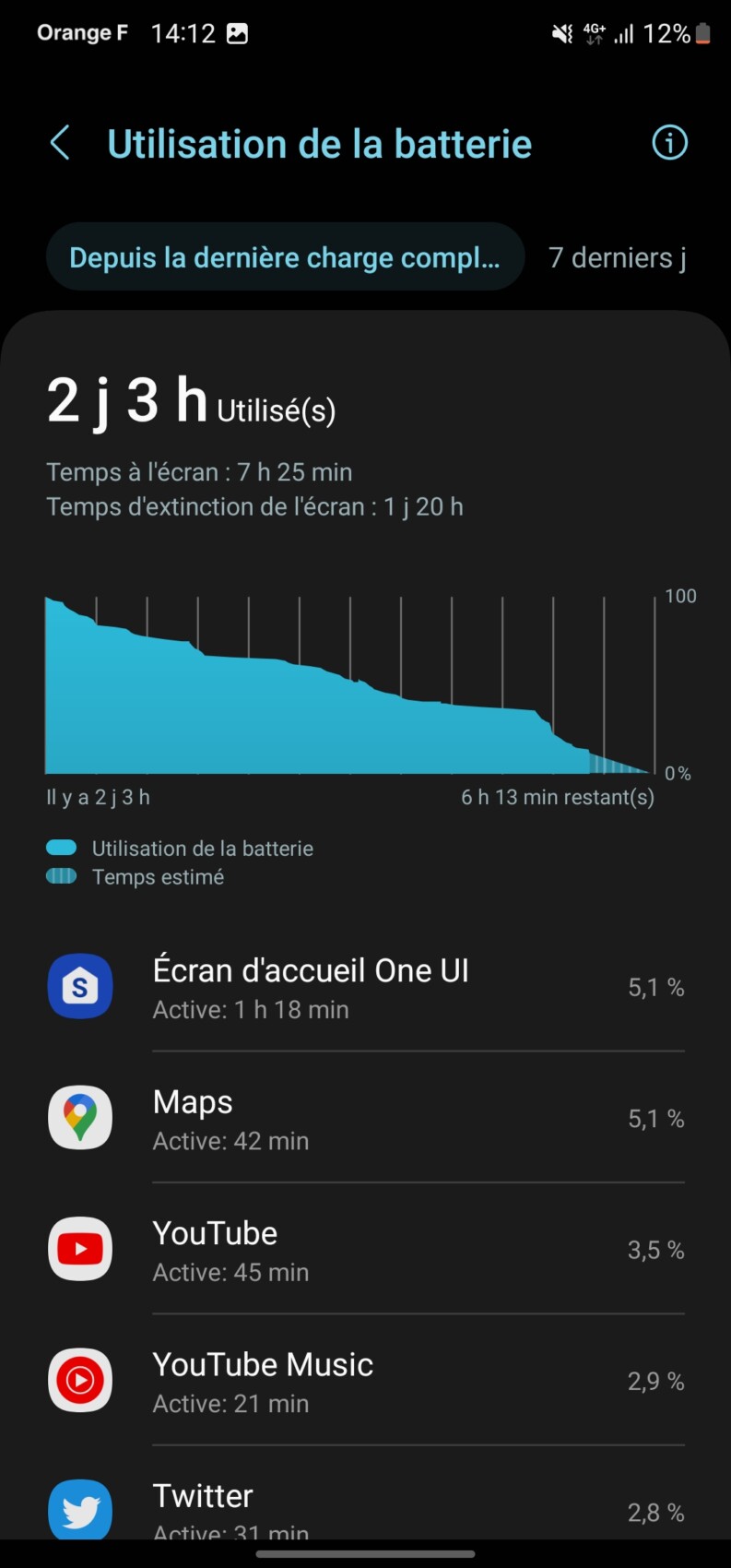
Tested using ViSer software and our custom protocol simulating varied usage, the phone took 15 hours and 14 minutes to reach 10% battery life. This is an excellent score, ranking 12th out of the 86 latest phones we tested.
Charging
With such battery life, one might think charging speed is not crucial. Samsung has slightly upped its game since the Galaxy S22 by increasing the charger to 45W. Unfortunately, this charger is not included in the box and costs $50.
We tested the S23 Ultra’s charging using this charger, starting at 3% battery life. Here are the results:
- 5 minutes : 14 % ;
- 10 minutes : 24 % ;
- 15 minutes : 35 % ;
- 30 minutes : 65 % ;
- 45 minutes : 87 % ;
- 55 minutes : 94 % ;
- 60 minutes : 96 %.
Samsung Galaxy S23 Ultra Audio: a bit too shrill
The audio quality of the Galaxy S23 Ultra is not its strongest feature. Samsung’s phone offers sound that leans a bit too much towards high-pitched tones.
This does not improve as the phone’s volume increases. The highs become even more prominent, while mid-tones remain somewhat noticeable at half volume. Bass is virtually nonexistent. The maximum volume is not very high, and the balance between the two speakers is not maintained, with the earpiece speaker only serving as support. In games, it is challenging to pinpoint the origin of sounds.
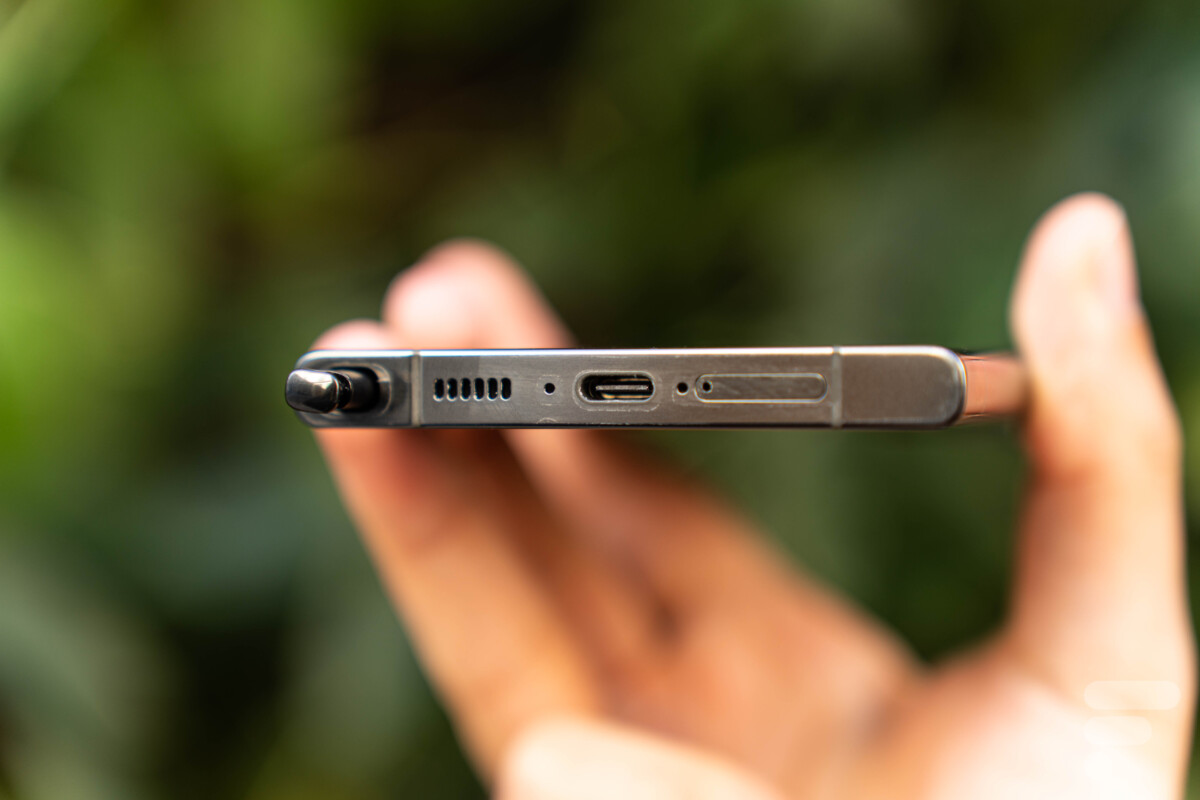
In short, we do not recommend using the S23 Ultra without wireless headphones or earbuds.
Samsung Galaxy S23 Ultra Networks and Communications
When making calls on a busy boulevard, the Galaxy S23 Ultra performs well. The sound is clear, the conversation is understandable, and most importantly, background noise is efficiently filtered, with slight robotic tones occasionally present. Some sudden sounds may still filter through while speaking, but they remain mostly subdued. The microphone effectively cuts out when silent.
The Galaxy S23 Ultra is a 5G phone. It theoretically supports mmWave, but only American versions offer this. Additionally, it features WiFi 6E, Bluetooth 5.3, and an NFC chip. Ultra-Wide Band is also included. I experienced no issues with the GPS chip during my test.
Samsung Galaxy S23 Ultra Price and Release Date
The Samsung Galaxy S23 starts at $999 for the 256GB + 8GB RAM variant on Amazon. It then increases to $1,049 for the 512GB + 12GB RAM version and $1,449 for the 1TB + 12GB RAM model.
Four basic colors are available: green, black, lavender, and cream. Three additional colors are offered on Samsung’s store: graphite, sky blue, and lime.
Samsung Galaxy S23 Ultra Frequently Asked Questions
How is the Galaxy S23 Ultra better than the Galaxy S23? Is it 5G compatible? Can it withstand being submerged in water? We answer all your questions.
What are the differences between the S23 and S23 Ultra?
It can be challenging to list all the differences, as there are many. Here are the primary distinctions:
- When upgrading to the Ultra, you gain an additional camera module, the X10, which allows for greater adaptability;
- The main sensor changes on the S23 Ultra, increasing to 200 megapixels, a larger size, and incorporating a laser autofocus;
- The Galaxy S23 Ultra is heavier and bulkier than the Galaxy S23;
- The display, besides being larger on the Ultra (6.8 inches vs. 6.1 inches), has a higher resolution (QHD vs. FHD), displaying more pixels;
- The Galaxy S23 Ultra includes a stylus;
- The Galaxy S23 Ultra starts with 256 GB of storage, which is also more efficient (UFS 4.0). To achieve the same quality with the Galaxy S23 vanilla, you need to purchase the 256 GB model;
- The Galaxy S23 Ultra features 12 GB of RAM, compared to 8 GB of RAM on the S23;
- The maximum charging capacity increases to 45W from 25W, and the battery size grows from 3900 mAh to 5000 mAh.
Is the Samsung Galaxy S23 Ultra 5G compatible?
Yes, the Samsung Galaxy S23 Ultra is 5G compatible. It can access all the bands of the 5G network currently used in USA, meaning all 5G bands except the mmWave. The phone also works with a 4G chip.
Is the Samsung Galaxy S23 Ultra waterproof?
The Samsung Galaxy S23 Ultra has the second-highest water resistance certification, IP68, which guarantees immersion in water over 1 meter for 30 minutes.
Our opinion on the Samsung Galaxy S23 Ultra
Design
What can be criticized about this design other than its square shape? It is a real success: Gorilla Glass Victus 2, IP68, improved handling with straight edges, the presence of an S-Pen, a very sleek appearance… It is top-notch.
Screen
Brightness, colors, size, definition, fluidity… it is almost perfect. It only lacks a little precision, but it is still enjoyable.
Camera
As with each year, it is a pleasure to have the versatility of Samsung’s Ultra with its X10 and X3, allowing for a very effective ultra-wide-angle lens. It may not be as dazzling as desired in night mode or portrait mode, but it compensates with a significant gain in clarity this year. The video part is assured with effective stabilization, making you the official photographer in your group.
Performance
The Snapdragon 8 Gen 2 fulfills all its promises. Daily performance avoids hassles, and you can finally try the most demanding games without flinching. Overheating is not an issue.
Software
With its four years of Android updates and five years of support, its multiple small additions (camera assistant, S-Pen integration, focus modes, etc.), Android 13 features (ability to cut game entry notifications, for example), and improved fluid animations, One UI regains its prestige. The only downside is that One UI is storage-hungry, taking up 40 GB.
Battery Life
A real pleasant surprise. With light use, you can easily exceed two days of battery life. It is a shame that the charge is so low and that the charger is not included in the box.
Editor’s Verdict
Has Samsung listened to our criticisms? While we might not be so narcissistic as to think so, that’s certainly the impression the Korean company gives us this year. Battery life was an issue? It’s largely resolved with an incredibly durable smartphone that will last you a full day without any problem, and even go into a second day without breaking a sweat. The chip overheating and displaying poor performance? That’s fixed too, as everything runs smoothly with the Snapdragon 8 Gen 2, which also has the good sense not to overheat.
We particularly appreciate the change in direction initiated with the S22 Ultra, and its square design inspired by the Note series, which includes the S-Pen as a bonus. The advanced camera versatility is still present, allowing creative expressions that only an ultra-premium device can offer. One UI 5.1 also addresses the earlier issues with Samsung’s in-house interface, greatly improving animations and adding even more control over usage modes and camera settings with the Camera Assistant. As usual with Samsung, whose Display division supplies most of the market, the screen quality is not even a concern as we are used to it being top-notch.
As you can understand, with this Galaxy S23 Ultra, we are more than satisfied, but we still want more. The few flaws we found in this review are minor compared to its numerous strengths. It was close to a 10/10. Most importantly, we feel that Samsung has finally found the right balance to avoid the frustrating compromises of last year, which we don’t want to hear about on a phone at this price. The price, indeed, may be the only issue and the most significant barrier that should curb your enthusiasm.
Samsung Galaxy S23 Ultra Pros:
- Finally, a Snapdragon chip
- Versatile camera with sharp details
- Incredible battery life
- The S-Pen
- High-quality screen
- Four years of Android updates
Samsung Galaxy S23 Ultra Cons:
- The price
- No fast charging or charger included
- Slight lack of color accuracy and HDR content
- Sound a bit too focused on high frequencies

